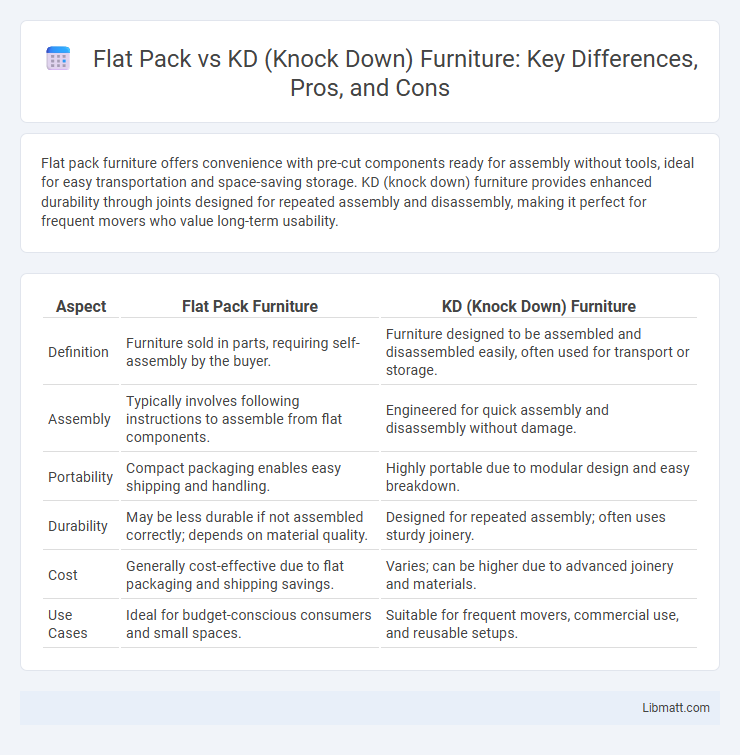Flat pack furniture offers convenience with pre-cut components ready for assembly without tools, ideal for easy transportation and space-saving storage. KD (knock down) furniture provides enhanced durability through joints designed for repeated assembly and disassembly, making it perfect for frequent movers who value long-term usability.
Table of Comparison
| Aspect | Flat Pack Furniture | KD (Knock Down) Furniture |
|---|---|---|
| Definition | Furniture sold in parts, requiring self-assembly by the buyer. | Furniture designed to be assembled and disassembled easily, often used for transport or storage. |
| Assembly | Typically involves following instructions to assemble from flat components. | Engineered for quick assembly and disassembly without damage. |
| Portability | Compact packaging enables easy shipping and handling. | Highly portable due to modular design and easy breakdown. |
| Durability | May be less durable if not assembled correctly; depends on material quality. | Designed for repeated assembly; often uses sturdy joinery. |
| Cost | Generally cost-effective due to flat packaging and shipping savings. | Varies; can be higher due to advanced joinery and materials. |
| Use Cases | Ideal for budget-conscious consumers and small spaces. | Suitable for frequent movers, commercial use, and reusable setups. |
Introduction to Flat Pack and KD (Knock Down) Furniture
Flat pack and KD (knock down) furniture both refer to products designed for easy transport and self-assembly, with flat pack typically featuring pre-packaged components in compact boxes. KD furniture emphasizes modularity and ease of assembly, allowing individual pieces to be knocked down or disassembled for storage or moving. Your choice between flat pack and KD furniture depends on convenience, space-saving needs, and how often you plan to assemble or relocate the items.
Key Differences Between Flat Pack and KD Furniture
Flat pack and KD (knock down) furniture differ primarily in assembly and packaging methods, with flat pack items typically packed in flat boxes requiring complete assembly, while KD furniture often comes partially assembled or with fewer components to assemble. Flat pack furniture prioritizes compact packaging for easier transport and storage, whereas KD furniture focuses on modular design allowing for simpler disassembly and reassembly. Your choice between flat pack and KD furniture will depend on your preference for assembly effort and transport convenience.
Assembly Process: Flat Pack vs. KD Furniture
Flat pack furniture requires precise assembly using pre-drilled holes and included hardware, making it user-friendly for DIY enthusiasts and ensuring consistent structural integrity. KD (knock down) furniture features modular components designed for quick disassembly and reassembly, ideal for frequent movers or temporary setups, often relying on specialized connectors. Both assembly processes impact durability and convenience, with flat pack emphasizing straightforward construction and KD prioritizing flexibility and portability.
Cost Comparison: Which Is More Affordable?
Flat pack furniture generally offers a more affordable price point compared to KD (knock down) furniture due to mass production and streamlined packaging that reduces shipping costs. KD furniture, designed for easier disassembly and reassembly, often involves higher manufacturing complexity and premium materials, leading to increased expenses. Your choice between flat pack and KD should consider not only upfront costs but also long-term value and convenience in assembly and durability.
Material Quality and Durability Analysis
Flat pack furniture typically uses engineered wood like MDF or particleboard, which offers affordability but can compromise long-term durability compared to KD (knock down) furniture that often incorporates solid wood or higher-grade plywood for enhanced material quality. The durability of KD furniture is generally superior due to robust joinery methods and stronger materials that withstand frequent assembly and disassembly without losing structural integrity. If you prioritize longevity and material resilience, KD options provide better value, while flat pack is suited for budget-conscious, short-term use.
Transportation and Storage Efficiency
Flat pack furniture offers superior transportation and storage efficiency due to its compact, disassembled form that reduces volume and maximizes space utilization during shipping. KD (knock down) furniture, while also designed for disassembly, often requires larger or more irregularly shaped packaging, which can lead to less optimized storage and higher transportation costs. Choosing flat pack solutions can streamline logistics and minimize expenses related to moving and storing your furniture.
Design Flexibility and Customization Options
Flat pack furniture offers limited design flexibility with standardized components that suit mass production, while KD (knock down) furniture provides greater customization options through modular parts allowing unique configurations. KD designs enable you to tailor dimensions, finishes, and features to match personal preferences and specific spatial requirements. This adaptability makes KD solutions preferable when your project demands bespoke aesthetics and functionality.
Environmental Impact and Sustainability
Flat pack furniture typically has a lower environmental impact than KD (knock down) furniture due to more efficient packaging and reduced transportation emissions. Your choice of flat pack products often supports sustainability by minimizing waste and optimizing material use during manufacturing. Selecting eco-friendly flat pack options can significantly reduce your carbon footprint compared to traditional KD furniture designs.
User Experience: Pros and Cons of Each Type
Flat pack furniture offers easy transportation and cost-effectiveness, making it ideal for users who prioritize affordability and convenience. However, it often requires more time and skill for assembly, which may lead to user frustration or errors. KD (knock down) furniture typically provides sturdier construction and simpler assembly processes, enhancing your overall experience with faster setup and greater durability, though it can be heavier and less compact to transport.
Conclusion: Choosing the Right Furniture for Your Needs
Flat pack furniture offers affordability and ease of transport, making it ideal for budget-conscious individuals and those frequently relocating. KD (knock down) furniture provides superior durability and sturdiness, suitable for long-term use in homes or offices requiring robust construction. Selecting the right furniture depends on balancing cost, convenience, and longevity based on your specific lifestyle and space requirements.
Flat pack vs KD (knock down) Infographic

 libmatt.com
libmatt.com